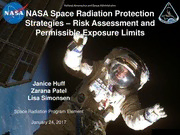
NASA Technical Reports Server (NTRS) 20170001372: NASA Space Radiation Protection Strategies - Risk Assessment and Permissible Exposure Limits NASA Space Radiation Protection Strategies: Risk Assessment and Permissible Exposure Limits PDF
Preview NASA Technical Reports Server (NTRS) 20170001372: NASA Space Radiation Protection Strategies - Risk Assessment and Permissible Exposure Limits NASA Space Radiation Protection Strategies: Risk Assessment and Permissible Exposure Limits
National Aeronautics and Space Administration NASA Space Radiation Protection Strategies – Risk Assessment and Permissible Exposure Limits Janice Huff Zarana Patel Lisa Simonsen Space Radiation Program Element January 24, 2017 Outline Space Radiation Program Element • Space Radiation Program Element Requirements • NASA Permissible Exposure Limits • Non-cancer PELs • Cancer PEL • Research Focus 2 SRPE Integrated Research Plan Meets Agency Requirements Space Radiation Program Element Develop & Modify Standards: Cancer PELs, Short-Term/non-cancer (CNS, CVD, ARS) • 4.1.3 The SR shall perform the research necessary to enable the development and modification of the SR standards sets documented in NASA - STD- 3001, Vol.1 and Vol. 2. Risk Characterization & Monitoring: • 5.1.6 The SR shall qualitatively or quantitatively assess the Space Radiation-applicable risks • 5.4.5 The SR shall provide evidence to support determination of status for SR-applicable concerns • 5.3.5 The SR shall develop methods and technologies to monitor indicators of adverse outcomes of SR-applicable risks Risk Mitigation: Physical and Biomedical Countermeasures • 5.2.5 The SR shall develop countermeasures and technologies, or provide research evidence to inform mission and vehicle requirements, to prevent or mitigate adverse outcomes of SR-applicable risks • 6.4.3 The SR shall develop methods and technologies to reduce human systems resource requirements (mass, volume, power, crew time, etc.). From: HRP-47052, HRP Program Requirements Doc 3 Space Radiation Program Element - Research Strategy Space Radiation Program Element Maintain Balance Across Four Distinct Risk Areas Based on Mission Drivers and State-of-Knowledge: – Meeting Cancer Career PEL is design driver for GCR & SPE shielding, mission duration, and crew selection - • Mission driver: younger female crew have highest risk (highlights importance of age and sex dependence) • By exceeding Cancer PELs & accepting increased risk – begin to exceed thresholds for CNS and CVD risks – Research with animal models shows changes to the CNS occur at HZE exposure levels in range of concern to NASA - • Significance to morbidity in humans (in-flight or late) and modification of risk by other spaceflight factors not understood – Evidence for elevation of CVD risk at doses as low as 0.5 Gy - • Studies of A-bomb survivor data and epidemiology data from occupational and medical exposures – which will impact %REID career limits Current Portfolio Priority: Cancer, In-flight Central Nervous System (CNS), Cardiovascular, Acute Radiation syndromes, Late CNS 4 NASA Permissible Exposure Limits (PELs) Space Radiation Program Element • Current Radiation PELs are documented in NASA Space Flight Human Systems Standard Volume 1, Rev A: Crew Health • PELs are in place to prevent clinically significant adverse outcomes and/or limit risk to a level that NASA deems acceptable to the crew • PELs are in place to protect against both short-term and late health effects • PELs are important for mission design including vehicle design, shielding configuration, mission length and crew certification for flight 5 NASA Permissible Exposure Limits - Background Space Radiation Program Element Congress has chartered the National Council on Radiation Protection (NCRP) to guide Federal agencies on radiation limits and procedures • NCRP guides NASA on astronaut dose limits • Basis for current PELs - NCRP Report No. 132 (2000) Radiation Protection Guidance for Activities in Low-Earth Orbit 6 NASA Permissible Exposure Limits - Cancer Space Radiation Program Element Career exposure to radiation is limited to not exceed 3% risk of exposure‐induced death (REID) from fatal cancers, measured at the 95% confidence level • Less than 1 in 33 chance of early death • Best estimate is 15-years average life loss for space radiation attributable cancer • Confidence level depends on exposure type (GCR, SPE) Based on 1989 comparison of risks in “less- safe” industries 95% confidence is conservative and is intended to account for uncertainties inherent in risk projection model – vary from 50% - <300% Cancer Risk Assessment – NSCR2012 Space Radiation Program Element Flow chart for REID and REIC calculations F.A. Cucinotta, M.-H.Y. Kim, and L.J. Chappell. 2011. Space Radiation Cancer Risk Projections and Uncertainties— 2010. NASA/TP-2011-216155 8 Cancer Risk-to-Dose Relationship Space Radiation Program Element • The relationship between radiation exposure and risk is age- and sex- specific related to latency effects and differences in tissue types, sensitivities, and life- spans between sexes • Limits for other career or mission lengths vary and can be calculated using the appropriate life-table formalism and projections in risk uncertainties • The 95th percentile confidence level using uncertainties in risk projections must be applied to these values 9 Uncertainties in Risk Assessment Space Radiation Program Element • Radiation Quality - Q • Qualitative and quantitative differences between space radiation compared with x-rays or gamma rays • Dose-rate reduction factors • Dependence of risk on the dose rates encountered in space • Epidemiology data • Statistics, Bias, Transfer to US population • Predicting Radiation Environment • Measurement dosimetry, space Major Uncertainties in Cancer Risk Model Durante and Cucinotta, Nature Rev. Cancer, 2008 environment, radiation transport models 10
